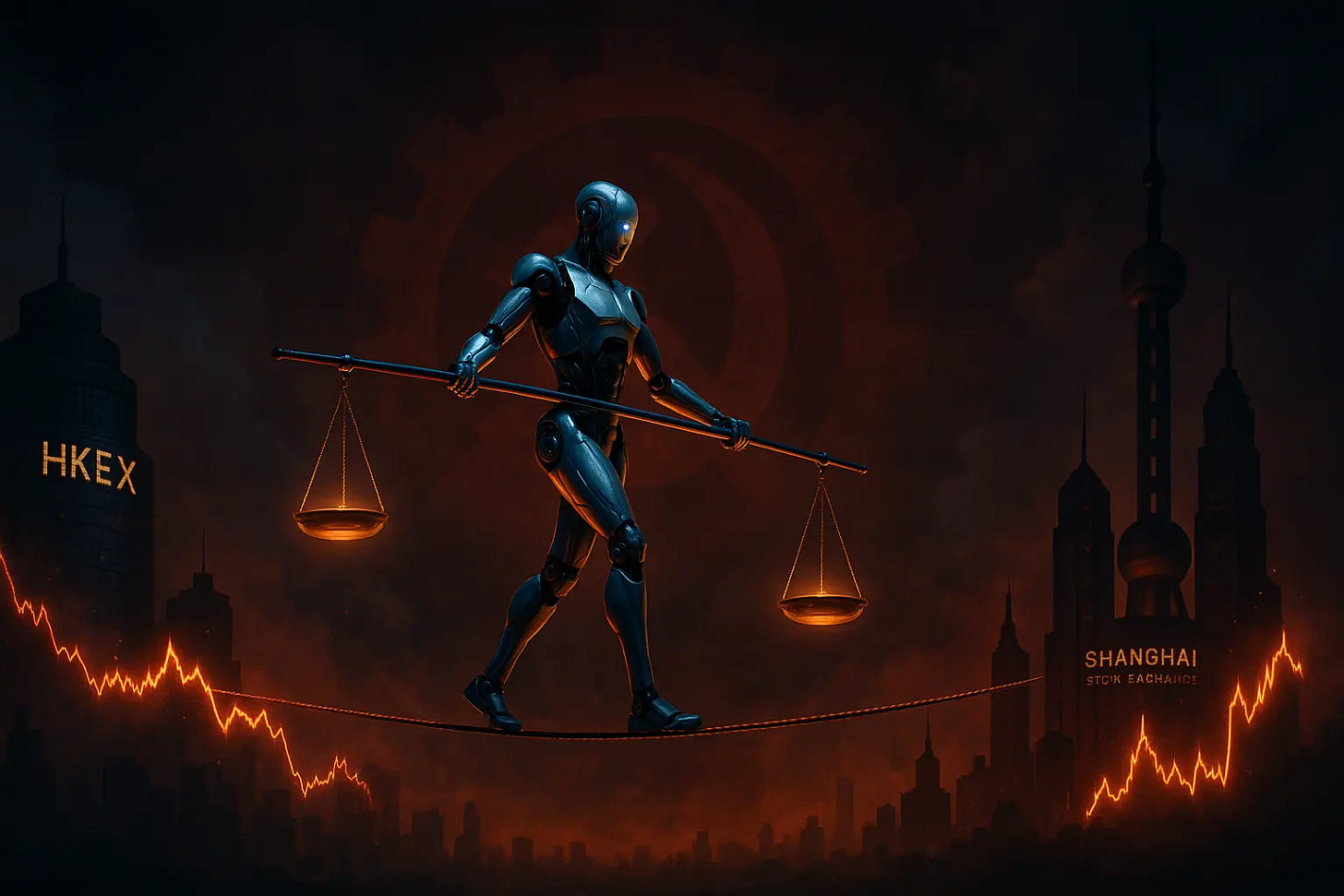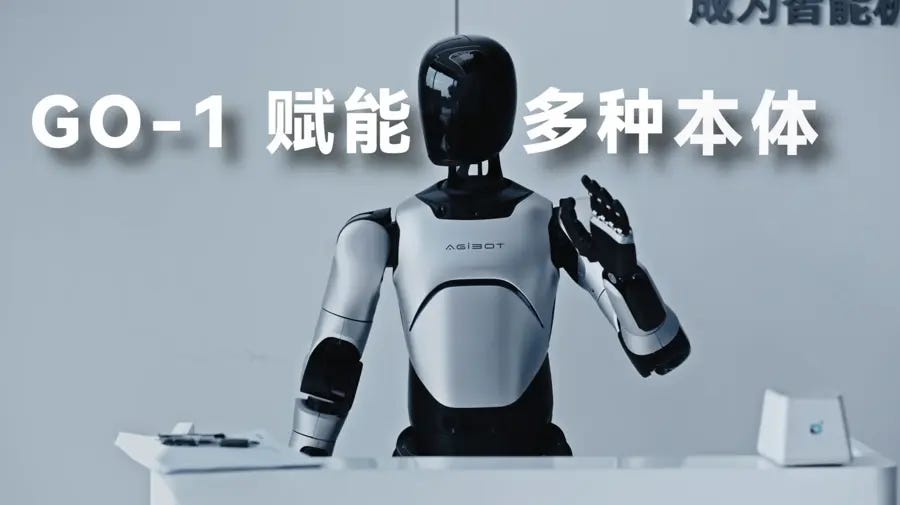Hello China Tech by Poe Zhao – Weekly insights into China’s tech revolution. I analyze how developments in Chinese AI, electric vehicles, robotics, and semiconductors are reshaping global technology landscapes. Each piece contextualizes China’s innovations within worldwide market dynamics and strategic implications.
While the West assesses the fallout from its SPAC boom, Beijing is pioneering a new form of financial strategy to fuel its technological ambitions. The immediate goal isn’t just to build robots; it’s to master the architecture of capital itself.
In the world of high finance, speed and access to capital are decisive weapons. As American investors continue to analyze the consequences of the blank-cheque boom, a more sophisticated and strategically significant drama is unfolding in China. It centers on the nation’s robotics industry, where a frantic rush to the public markets has less to do with commercial maturity and everything to do with a multi-layered game of capital arbitrage, sanctioned and subtly guided by the state.
The most notable move came on a quiet evening in early July. Zhiyuan Robotics (智元机器人), a celebrated robotics startup founded just two and a half years ago, announced a deal that would see an affiliated company take control of Swellfun (上纬新材), a materials company listed on Shanghai’s tech-focused STAR Market. While the deal was carefully structured to avoid official “backdoor listing” regulations, the market’s interpretation was unequivocal: this was an astute maneuver to bypass China’s notoriously long IPO queues and seize a public platform. The target company’s shares surged over 400% in nine days.
This is not a simple story of tech euphoria. It is a calculated strategy, revealing how China is leveraging the very structure of its capital markets as a tool of industrial policy. Startups are exploiting the vast regulatory and valuation differences between mainland China and Hong Kong, and venture capitalists are arbitraging the rigid lifecycles of their own funds.
What is emerging is a speculative bubble with Chinese characteristics: one that is not an accidental byproduct of market mania, but an instrument in the global race for technological supremacy. To understand this phenomenon is to understand a core pillar of China’s competitive strategy.
The Urgency of the Exit: Arbitraging the Venture Capital Lifecycle
The first layer of this arbitrage game is driven by a simple, unyielding reality: the venture capital clock is ticking. The robotics IPO wave is less a triumphant graduation ceremony and more a pressured, urgent scramble for an exit, compelled by investors who are running out of time.
This dynamic is best understood through the concept of 被架上市 (bèi jià shàngshì), a term circulating in Chinese investment circles that translates roughly to a “coerced” or “forced” listing. It describes a situation where a company is effectively pushed onto the public market by its investors, primarily to serve their own exit timelines rather than the company’s intrinsic strategic schedule.
Consider the case of Unitree (宇树科技), a pioneer in four-legged robots and a key supplier for China’s highly-watched Spring Festival Gala robotics display. Founded in 2016, the company has raised eleven rounds of funding from a premier list of Chinese venture capital, including early backers like Sequoia China and the investment arm of tech giant Meituan (美团). For these investors, whose funds were launched nearly a decade ago, the standard 7-to-10-year fund lifecycle is reaching its terminal point. They are legally and fiduciarily obligated to liquidate assets and return capital to their own limited partners.
The pressure is immense. As one investor bluntly told Chinese media, “If we don’t go public now, we might not survive.” This is not hyperbole. It is the raw logic of capital. For a company like Unitree, an IPO ceases to be a strategic choice to be timed for maximum advantage; it becomes a necessity to solve its investors’ liquidity crisis. The company’s readiness for the rigors of the public markets is secondary to the fund’s need to close its books.
This represents a clear time arbitrage. Investors are trading the potential for a higher valuation in a more mature future for the certainty of liquidity today. In doing so, they are forcing a generation of deep-tech companies, which by nature require long and patient development cycles, onto the unforgiving quarterly reporting treadmill of the public markets.
The Hong Kong Route: A Play on Regulatory Asymmetry
If the VC clock explains the urgency of the IPO rush, the unique structure of the Hong Kong Stock Exchange (HKEX) explains the feasibility. For the vast majority of Chinese robotics firms, profitability remains a distant objective. The industry is defined by high R&D expenditures—often 20% to 50% of revenue for leading players—and protracted commercialization cycles. According to industry analysis from Chinese sources, of the 12 most prominent robotics companies currently in the IPO pipeline, a striking 10 were unprofitable in 2024.
These firms would face significant hurdles on mainland China’s A-share market, which, despite reforms, still favors a track record of stable profits. Hong Kong, however, provides a critical alternative pathway. Its Chapter 18C, a listing rule implemented specifically to attract pre-revenue specialist technology companies, offers a more permissive regulatory environment. This provision has become the key enabler for this wave of listings.
In June alone, a cohort of robotics companies, including Stand (斯坦德), Mega (镁伽科技), and Estun (埃斯顿), filed for listings with the HKEX. They were joined by Geek+ (极智嘉), a warehouse logistics robot maker which, despite generating over 70% of its revenue from overseas and holding a leading global market share, still booked a net loss of 832 million RMB in 2024. For these companies, Hong Kong offers regulatory forbearance. It is a jurisdiction willing to prioritize the promise of long-term technological leadership and global reach over short-term profitability. This is a clear case of regulatory arbitrage: companies are flocking to the market with the lowest barriers to entry to secure the vital capital needed to continue their high-burn operations.
The A-Share Prize: Arbitraging Control and Valuation
While many firms pursue the Hong Kong route for survival, the sector’s elite are playing a more sophisticated game on the mainland. The maneuver by Zhiyuan Robotics is the preeminent example. It represents a third, more potent form of arbitrage combining the acquisition of corporate control with the pursuit of higher market valuation.
The deal was a notable example of financial engineering. Through a “three-step” strategy involving a share transfer, the surrender of voting rights by the original owner, and a partial tender offer, Zhiyuan Robotics’s founders secured control of a public company. The structure allowed them to circumvent the strict regulations governing a formal “backdoor listing,” which require the acquirer to be profitable and established for at least three years. Zhiyuan Robotics is neither.
This strategy serves two primary purposes. First, it provides a pre-packaged path to liquidity for its powerful early backers, a syndicate that includes Tencent (腾讯), Hillhouse Capital (高瓴资本), and automotive giant BYD (比亚迪). They now have a clear future exit route in the highly liquid A-share market, bypassing the long waits and uncertainties of a traditional IPO process.
Second, and more importantly, it establishes a strategic platform for future capital raising. By controlling a public shell, Zhiyuan Robotics can, in the future, inject its own robotics assets into the listed entity, potentially at the high valuations typically afforded to high-concept technology firms by mainland Chinese investors. It is an arbitrage against time, regulation, and ultimately, market perception, securing a high-value platform from which to launch its next phase of growth.
This has sparked sharp debate within China’s tech community. “So, the money raised from the primary market isn’t for R&D, but to buy a public company’s shares?” one industry insider lamented in a widely circulated comment. The question cuts to the heart of a dangerous paradox. When the mechanics of a listing become an end in itself—a more urgent goal than product development or customer acquisition—it raises critical questions about whether capital is being allocated for productive innovation or for accelerating investor returns through market engineering.
A Bubble Engineered for a Purpose
The inevitable result of this frenzy is a valuation bubble of immense proportions. Unitree is reportedly valued at over 12 billion RMB ($1.65 billion), while Zhiyuan Robotics’s deal implies a valuation north of 15 billion RMB ($2 billion). These are substantial figures for companies that are largely pre-revenue and whose flagship humanoid products are still, by their own admission, in the “functional demonstration” stage, facing enormous hurdles in cost, mass production, and real-world application.
Yet, to dismiss this as simple irrational exuberance would be to miss the strategic intent. This appears to be a bubble engineered for a purpose, inflated by a convergence of interests. For the VCs, it validates their high-risk, long-term bets. For the companies, it provides the war chest needed to survive a capital-intensive R&D phase. And for the state, it serves a national purpose. Beijing has explicitly named “Embodied Intelligence” as a key strategic industry to be developed. By allowing, and even facilitating, this capital market maneuvering, the state ensures that its chosen champions have the resources to compete globally, regardless of their short-term financial performance.
The competition in China’s robotics sector is not currently about who can build the most efficient robot. It is about who can best master this complex game of capital arbitrage. The winners will not necessarily be the companies with the superior technology today, but those who can most effectively navigate the currents between venture capital exit pressures, divergent stock market regulations, and the strategic embrace of their state backers. The primary innovation on display is not yet in robotics, but in the strategic use of capital market structures to advance national industrial goals. For global investors and policymakers observing China’s technological rise, understanding this deep interplay of finance and statecraft is no longer optional—it is essential.
About Hello China Tech
I’m Poe Zhao, and I bridge the gap between China’s rapidly evolving tech ecosystem and the global community. Through Hello China Tech, I provide twice-weekly analysis that goes beyond headlines to examine the strategic implications of China’s technological advancement.
Found this useful?
→ Share this newsletter with colleagues who need to understand China’s tech impact
→ Subscribe for free to receive every analysis:
→ Follow the conversation on 𝕏 for daily updates and additional insights
Get in touch: Have questions about China’s tech sector or suggestions for future analysis? Reply to this email – I read every message.









